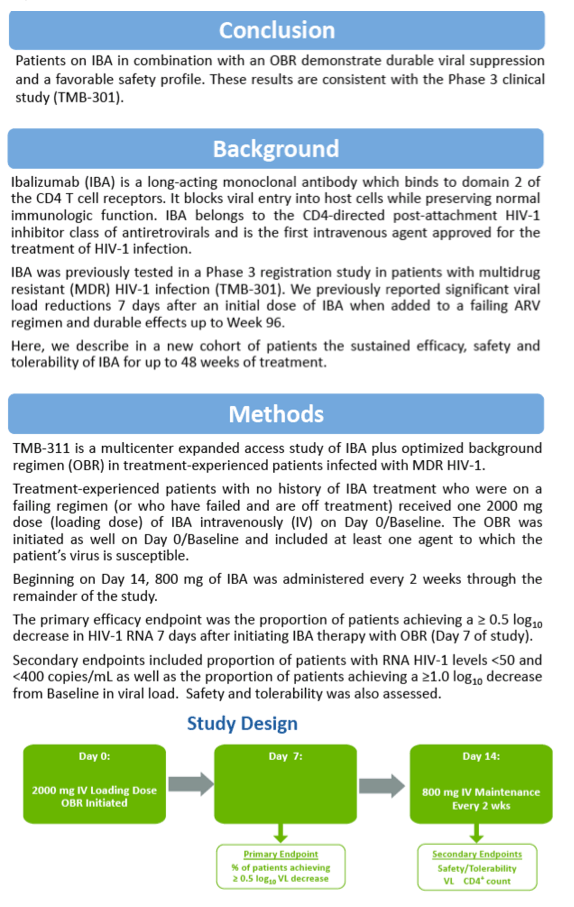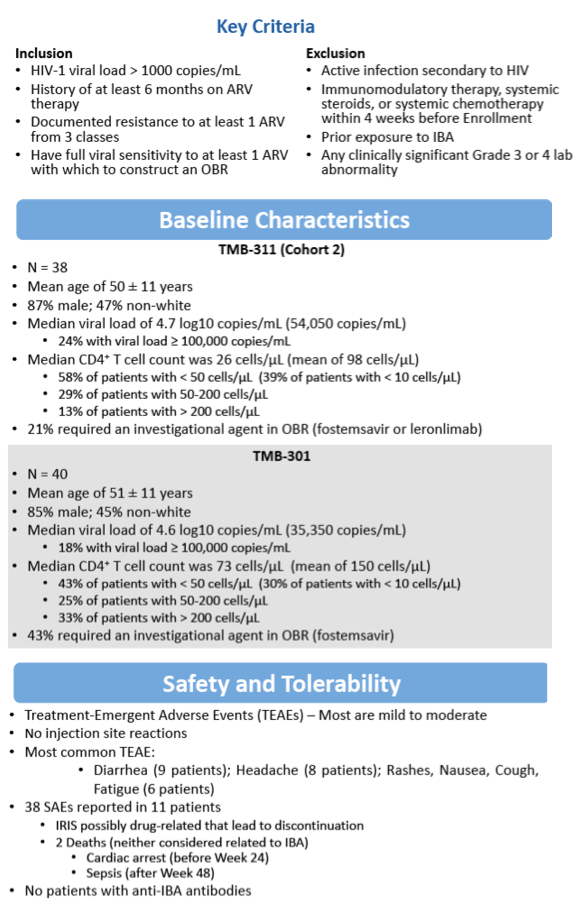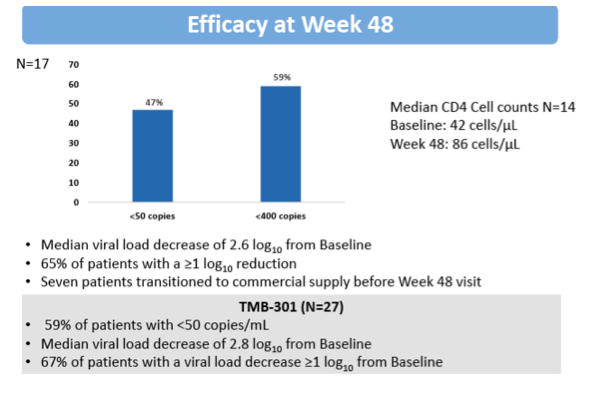 |
 |
 |
| |
IBALIZUMAB EFFICACY AND SAFETY THROUGH 48 WEEKS OF TREATMENT:
RESULTS OF AN EXPANDED ACCESS PROTOCOL (TMB-311)
|
| |
| |
Reported by Jules Levin
ID Week 2019 Oct 2-6 Wash DC
IDWeek 2019: HIV Suppression and Safety With Ibalizumab at 48 Weeks in Expanded Access - Mark Mascolini (10/4/19)
B. EMU1, E. DEJESUS2, M. BERHE3, J. LEIDER4, C. CRETICOS5, S. WEINHEIMER6, Z. COHEN7
1Yale University, New Haven, CT, 2Orlando Immunology Center, Orlando, FL, 3North Texas Infectious Diseases Consultants, Dallas, TX, 4Jacobi Medical Center, Bronx, NY
Program abstract
Background :
Ibalizumab (IBA), a humanized monoclonal antibody, is the first CD4-directed post-attachment HIV-1 inhibitor. It was approved by the FDA in March 2018 based on results from the pivotal Phase 3 TMB-301 clinical study.
The TMB-311 expanded access protocol Cohort 2 enrolled treatment-experienced patients with multidrug resistant (MDR) HIV-1 infection to further evaluate the efficacy, safety and tolerability of IBA in combination with an optimized background regimen (OBR). Here, we report the results through 48 weeks of treatment in these patients.
Methods : Major eligibility criteria included HIV-1 viral load (VL) > 1000 copies/mL, resistance to ≥1 antiretroviral (ARV) medication from three different ARV classes and full viral sensitivity to ≥1 ARV agent. Treatment started with IBA 2000 mg intravenously (IV) on Day 0 and then 800 mg IV (maintenance) every 2 weeks thereafter. OBR with ≥1 fully active agent also started at Day 0.
Results :
Cohort 2 enrolled 38 patients with a median age of 53 years, mostly male (87%) and white (53%). At Baseline, median VL was 4.7 log10 copies/mL, CD4 cell count was 26 cells/mm3 and overall susceptibility score of 1.
A ≥0.5 log10 decrease in VL from Baseline was achieved in 28 of 37 patients (76%) at Day 7. Of 24 patients who completed the Week 24 visit, 11 (46%) had HIV-1 RNA levels < 50 copies/mL. Of 17 patients with a VL assessment at Week 48, 8 (47%) achieved < 50 copies/mL. Seven patients did not have a Week 48 endpoint because they withdrew from the study to receive commercial IBA. At both timepoints, the median change in VL from Baseline was -2.6 log10 copies/mL.
The most frequently reported treatment-emergent adverse events (TEAEs) were diarrhea (24%), headache (21%), and nausea, cough, rash, and fatigue (16% each). No injection site reactions related to IBA were reported. Most events were mild; 9 patients reported Grade ≥3 TEAEs. Two events were fatal (sepsis and cardiac arrest); neither related to IBA. One event of immune reconstitution inflammatory syndrome was reported and considered possibly related to IBA.
Conclusion : Results from Cohort 2 patients of TMB-311 (IBA + OBR) demonstrate durable viral suppression in this difficult-to-treat patient population and with safety profile consistent with pivotal Phase 3 study of IBA.




|
| |
|
 |
 |
|
|